Physiotherapy
How to use crutches
This information has been translated into other languages – see the links at the bottom of this page.
Make sure the crutches fit
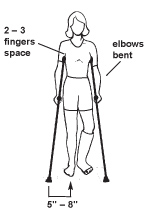
- Stand straight.
- Place the top of the crutches under your arms.
- Put the ends 12 to 20 cm (5 to 8 inches) to the side of your feet.
The crutches are the correct length if there is a 2- to 3-finger space between the top of the crutch pad and your armpit.
The hand grip should be at wrist level when your arm is hanging by your side. Your elbows are slightly bent as you push down on the hand grips.
Adjust the overall height of the crutch (the armpit measurement) first, then adjust the hand grip.
Remember:
Support your weight with the hand grips, not the crutch pads under your armpits.
Your weight-bearing order is:
| Non weight-bearing | No body weight on your injured leg. Keep your injured leg off the floor at all times. |
| Feather weight-bearing | Able to touch your toe to the floor for balance only. Don’t put any weight on your injured leg. Imagine having an egg under your foot that you don’t want to crush. |
| Partial weight-bearing | Able to put up to half your weight through your injured leg. |
| Weight-bearing as tolerated | Can take most or all your weight through your injured leg, as pain or strength allows. |
| Full weight-bearing | Able to take your full weight through your injured leg. |
Use the method you were shown with the instructions below.
Walking
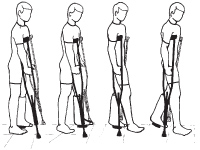
- Put the crutches ahead and to the sides of your feet for the best balance.
- Move both crutches forward at the same time.
- Move the injured leg forward between the crutches.
- Gently squeeze each crutch into your ribs. Put weight through your hands and keep your elbows straight.
- Move your stronger leg ahead of the crutches, or to between the crutches for better balance.
Repeat these steps to keep walking—crutches, injured leg, stronger leg.
Note: Don’t lean on the armpit pad. It can press on blood vessels and nerves.
Sitting
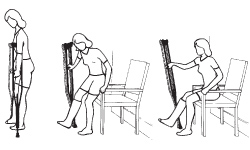
- Step backwards until the back of your stronger leg touches the front of the chair. Keep your injured leg forward.
- Keeping your weight on the uninjured leg, take the crutches from under your arms. Put 1 crutch in your other hand so you are holding both crutches by the hand grips in 1 hand.
- Lean forward and bend the knee on your stronger leg. Hold the armrest of the chair or seat of the chair with the other hand.
- Sit down slowly. Keep your crutches next to the chair.
Standing
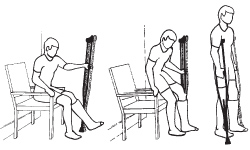
- Make sure the chair is steady before you try to stand.
- Move forward to the edge of the chair so the foot of your stronger leg is flat on the floor. Slide your injured leg forward and follow the weight bearing order.
- Hold the crutches by the hand grips in 1 hand. Hold the armrest of the chair or seat of the chair with the other hand.
- Stand up, taking weight through your stronger leg. Transfer the crutches under your arms after you get your balance.
Steps and stairs
- Use the railing if there is one. Put both crutches under the arm away from the railing (or hold as in the diagram below) and use both crutches as 1.
- Hold the railing with your free hand and stand close to the rail.
- On stairs without a railing: follow the instructions for going up and down stairs, except leave 1 crutch under each arm (as for walking).
Going up stairs
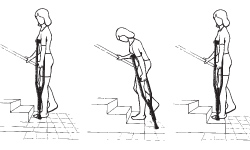
- Stand close to the bottom step.
- Put your stronger leg up first.
- Lean forward taking your weight on your stronger leg.
- Lift your injured leg and crutches up.
- Climb 1 step at a time. If someone is helping you, have them stand behind and to the side of you.
Going down stairs
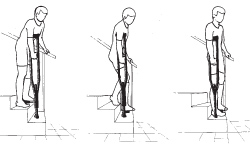
- Stand close to the edge of the top step.
- Move your hand down the railing.
- Lower your crutches, then your injured leg, to the next step.
- Step down with your stronger leg.
- Go down 1 step at a time. If someone is helping you, have them stand in front and to the side of you.
Using 1 crutch
Use the crutch in the hand opposite the injured leg. This gives you better support and helps you walk with more normal movements.
Using a 4-point gait style
Only use this method if your therapist has shown you. You’ll be shown either partial weight-bearing or weight-bearing as tolerated.
Follow these steps to walk:
- Move your right crutch forward.
- Move your left foot forward so it’s even with the right crutch.
- Move your left crutch forward.
- Move your right leg forward so it’s even with the left crutch.
Repeat these steps to keep walking.
Note: If you start with your left crutch, reverse the above order.
Follow the same instructions for crutch walking to:
- sit down
- stand up
- go up and down stairs
Safety tips
- Make sure that your crutches have rubber tips, padded shoulder pieces, and hand grips. Check them regularly, keep them in good condition, and replace them as needed.
- It’s important to use your crutches correctly. If you feel any numbness or tingling below your armpits or in your upper arms, review how to use crutches correctly or ask your physiotherapist for help.
- Never stand on your injured leg unless your doctor says you can.
- Wear supportive shoes or have bare feet rather than slippers.
- Use a waist pouch or a backpack as a purse.
- Watch for wet surfaces. Use small steps if you must walk on a wet or slippery surface.
- Be careful when walking on uneven ground. Ask for help if you need it.
- Remove loose mats and rugs, electric cords, and cables. These could cause you to trip or slip.
Your doctor or physiotherapist will tell you when you can stop using your crutches.
To see this information online and learn more, visit MyHealth.Alberta.ca/health/pages/conditions.aspx?Hwid=custom.ab_physio_crutches_inst.

Other languages
Physiotherapy: How to use crutches
For 24/7 nurse advice and general health information call Health Link at 811.
Current as of: November 14, 2023
Author: Allied Health (Physiotherapy), Alberta Health Services
This material is not a substitute for the advice of a qualified health professional. This material is intended for general information only and is provided on an "as is", "where is" basis. Although reasonable efforts were made to confirm the accuracy of the information, Alberta Health Services does not make any representation or warranty, express, implied or statutory, as to the accuracy, reliability, completeness, applicability or fitness for a particular purpose of such information. Alberta Health Services expressly disclaims all liability for the use of these materials, and for any claims, actions, demands or suits arising from such use.
